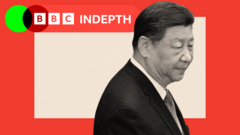China is at a crossroads, with President Xi Jinping's economic vision under scrutiny due to various internal challenges. Despite the imposing tariffs on Chinese goods by former President Donald Trump, many traders in China's wholesale markets aren't worried; instead, they ridicule the situation through memes and viral videos. The reality is that while the Chinese government historically emphasized self-reliance, the current economic climate reveals deep-rooted struggles, including a collapsing housing market that has left citizens hesitant to spend.
Home prices are expected to fall further, shattering the dreams of families who invested heavily in properties that now sit vacant. Nationwide, countless unfinished residential projects dot the landscape, and a looming pension crisis threatens the financial security of millions, exacerbating consumer pessimism. With inflation and unemployment high, domestic demand remains sluggish as youth unemployment surpasses 20% among those aged 16 to 24.
Xi's dreams of rejuvenating China, which began when he ascended to power over a decade ago, face significant tests today. As external trade pressures intensify, there's a pressing challenge for the Chinese economy to pivot from export reliance to bolstering domestic consumption. Despite government measures such as childcare subsidies and discounts on consumer goods attempting to stimulate the economy, experts warn about the sustainability of these initiatives long-term.
Moreover, the growing discontent among younger generations poses potential risks for the Communist Party, with financial grievances leading to increased protests. While the government swiftly suppresses dissent, the rising tide of unrest indicates an urgent need to address economic fears effectively.
In a bid to transform adversities into opportunities, Xi is turning attention to expanding trade ties outside the US, having previously capitalized on Trump's tariffs to diversify markets across Southeast Asia and beyond. Nevertheless, the specter of "dumping" cheaper goods into these markets raises concerns about future trade frictions.
Despite his efforts to assert China as a reliable global trade partner, Xi faces significant obstacles due to past trade restrictions that have left countries wary of Beijing's intentions. However, with the current administration’s wavering stance towards tariffs, there is speculation that a trade resolution might be on the horizon.
In this intricate tapestry of trade relationships, while the turbulence prompted by Trump's policies creates obstacles, it also nurtures an opportunity for China to introspect and reform its economic foundation—one that could determine the fate of Xi's enduring dream for a more prosperous China.
Home prices are expected to fall further, shattering the dreams of families who invested heavily in properties that now sit vacant. Nationwide, countless unfinished residential projects dot the landscape, and a looming pension crisis threatens the financial security of millions, exacerbating consumer pessimism. With inflation and unemployment high, domestic demand remains sluggish as youth unemployment surpasses 20% among those aged 16 to 24.
Xi's dreams of rejuvenating China, which began when he ascended to power over a decade ago, face significant tests today. As external trade pressures intensify, there's a pressing challenge for the Chinese economy to pivot from export reliance to bolstering domestic consumption. Despite government measures such as childcare subsidies and discounts on consumer goods attempting to stimulate the economy, experts warn about the sustainability of these initiatives long-term.
Moreover, the growing discontent among younger generations poses potential risks for the Communist Party, with financial grievances leading to increased protests. While the government swiftly suppresses dissent, the rising tide of unrest indicates an urgent need to address economic fears effectively.
In a bid to transform adversities into opportunities, Xi is turning attention to expanding trade ties outside the US, having previously capitalized on Trump's tariffs to diversify markets across Southeast Asia and beyond. Nevertheless, the specter of "dumping" cheaper goods into these markets raises concerns about future trade frictions.
Despite his efforts to assert China as a reliable global trade partner, Xi faces significant obstacles due to past trade restrictions that have left countries wary of Beijing's intentions. However, with the current administration’s wavering stance towards tariffs, there is speculation that a trade resolution might be on the horizon.
In this intricate tapestry of trade relationships, while the turbulence prompted by Trump's policies creates obstacles, it also nurtures an opportunity for China to introspect and reform its economic foundation—one that could determine the fate of Xi's enduring dream for a more prosperous China.




















